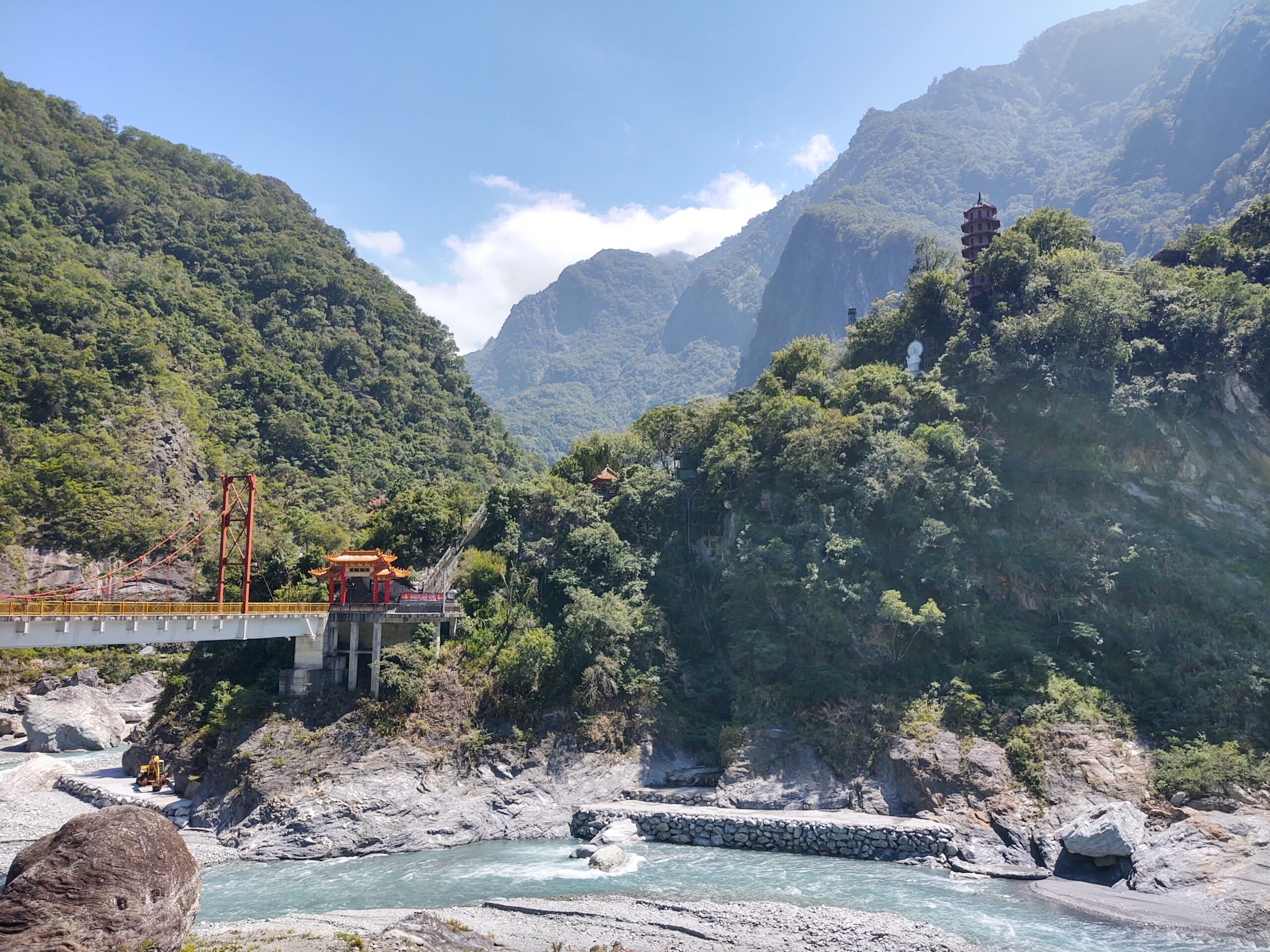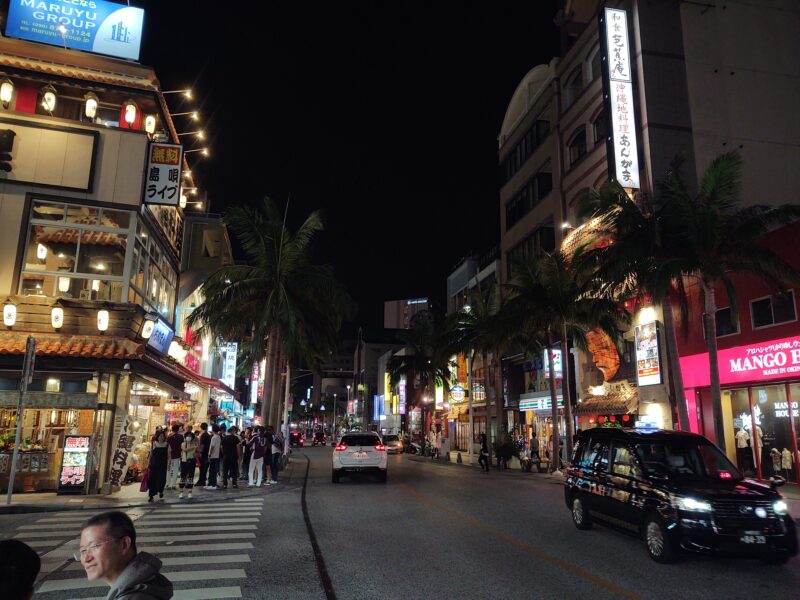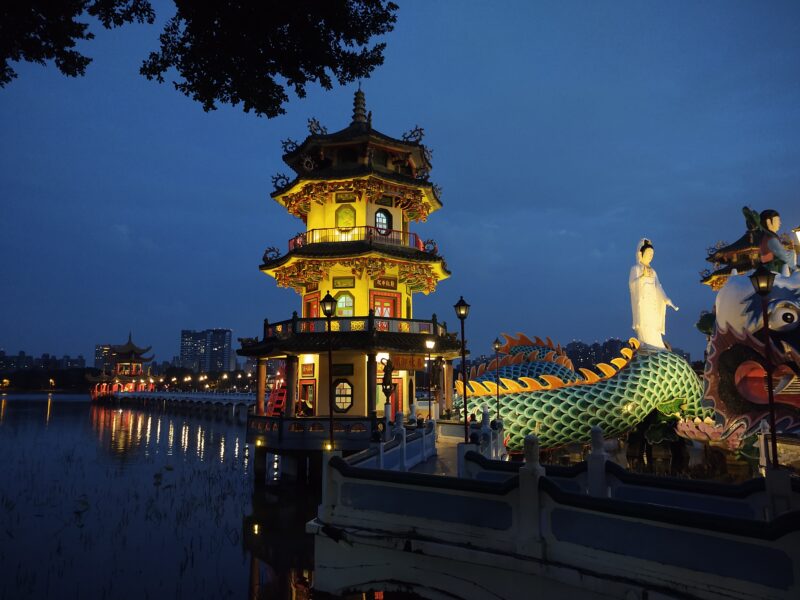See also:
Special thanks to Nick Kembel, whose guidance was indispensable in putting this trip together. His site, Taiwan Obsessed, is the ultimate reference for planning a Taiwan trip.
Welcome to Hualien
City faded into countryside as we rode the express train down the eastern coast to Hualien. As the sun set, we passed through idyllic scenes of rice paddies swaying gently in the wind while distant mountains towered on the horizon.
We arrived in Hualien just after dark. After checking into our hotel, we walked down the small city’s main street towards the coast to find some dinner. Eventually we stopped into a Korean restaurant that treated us to a feast of kimchi soup, curry cheese chicken, and savory seafood pancakes.
Cream went to bed early while I explored the charming local night market beside the ocean. It felt much less crowded and more laid-back than Taipei’s busy markets, possibly because of the late hour.
Day 3: Taroko Gorge
We arrived in Hualien a night early to tour Taroko Gorge, one of Taiwan’s most spectacular natural wonders.
Taroko National Park
On its way from Taiwan’s steep central mountains to the coast, the Liwu River carves and chisels its way through Taroko Gorge in Taroko National Park. The national park is a geologically active region where tectonic plate collisions cause the earth to rapidly rise.
The fight between quickly ascending marble and limestone mountains against the river’s powerful downward erosion created a dramatic landscape of incredibly steep canyons over the course of millions of years.
In the late 1950s, Chiang Kai Shek, Taiwan’s leader, decided to construct a road through the seemingly impenetrable gorge for commerce and defense.
If there wasn’t a road there already, I wouldn’t have believed that building one was even possible. Yet there it is, winding through the cliffs like the river beside it, carving its way out of the rock through dozens of tunnels, moving upward, upward, upward to central Taiwan.
The roadway precariously clings to the sides of the gorge, vulnerable to the region’s natural disasters such as earthquakes and landslides. It is frequently closed, but the local government makes significant efforts to keep it open as much as possible.
Touring Taroko Gorge is possible by renting a car and/or a driver, or by joining a group bus tour that hits all the best spots. We opted for the latter.
Qixingtan Beach
The whole Taroko area has interesting geology, and on our way to the gorge, we paused for a quick walk at Qixingtan Beach.
Qixingtan Beach is comprised of small, smooth gray pebbles. A heavy surf crashed against the shore, accenting the beautiful view up the mountainous coast.
It was the first great view and pinch me if I’m dreaming moment of the day. The contrasts between the beach’s grays, the ocean’s deep blues and foam whites, and the rolling jade mountain backdrop were simply breathtaking.
Swallow Grotto Trail
Our tour continued into Taroko National Park. Helmets were handed out immediately when we arrived at the Swallow Grotto Trailhead, one of the park’s most awe-inspiring walks.
When the Liwu River floods, it carries large stones higher up the sides of the gorge, eroding small potholes in the rocks. Birds make their nests in the little alcoves, giving the trail its name.
The trail was around 1 kilometer and fairly flat. Each turn revealed another incredible view, each more breathtaking than the last. With near-vertical cliffs on either side, every section was either a tunnel, an overhang, or a bridge. I felt a combination of tension and wonder from the landscape’s extreme severity as we slowly made our way through.
As we neared the end of the trail, our guide pointed straight up. “The sky looks like Taiwan island here,” he said, showing me a picture like the one I took below. We were engulfed in stone, cliffs rising on every side.
View of the sky compared to a map of Taiwan island.
Tianxiang and Xiangde Temple
The narrow road continued on through twists, turns, caves, and tunnels, winding along above the river.
We eventually reached a tiny village called Tianxiang, where we stopped for a lunch including delicious noodles, fried rice, and egg vegetable soup.
The river made a sharp turn beneath Tianxiang. On the other side, Xiangde Temple rose atop a cliff. A colorful suspension bridge connected the main road to the temple, completing one of the most sublime landscapes I’ve ever seen.
After lunch, we explored Xiangde Temple. This section of river was an audaciously pale blue. The mountains loomed in the distance, each section higher than the last.
I hiked up to the pagoda. Nearby, a statue of Guanyin quietly watched over the dramatic-yet-peaceful clearing below.
Buluowan Visitor Center
Our bus drove back through the gorge, this time turning and going straight up the mountainside to reach Buluowan Visitor Center, reaching into the clouds with a beautiful terrace and some scenic trails.
We got a great view of the suspension bridge that spans the gorge here, but it was closed that day so we couldn’t walk across. Instead, we hiked further up to Taroko Village, a secluded and upscale hotel built by the local aboriginal tribe, the Truku.
The views were lovely as we hiked back down. A light drizzle began to fall. The cooler temperatures were a pleasant escape from Taipei’s heat.
Eternal Spring Shrine
The bus continued back down the mountain to reach the Eternal Spring Shrine.
The Eternal Spring Shrine honors the 226 people who died while building the roadway due to the region’s frequent natural disasters. It’s a small shrine carved out of the cliffside, with a spring endlessly feeding a narrow waterfall beneath. Inside the building, visitors can read and memorize the names of the deceased, helping them live on for generations to come.
A short cave hike led us to the shrine, with a grand view of another turn in the river. This far downstream, the water appeared as gray as the stones it washed over.
Shakadang Trail
Our last stop of the day was to hike the Shakadang Trail, which starts near the entrance of the national park and works its way alongside a branching river. It’s fairly flat, with great views of the wildlife, water, and mountains.
Listening to the quiet wilderness, we soaked in the sounds of birds and the shimmering cobalt blue river running below. The hike was about an hour round trip, with a small aboriginal market at the turnaround point. We grabbed a refreshing jelly drink before making our way back out. It was the perfect low-key hike to end the jam-packed tour.
We returned to the train station and headed back to Taipei for the night.
Chun Shui Tang: The Original Bubble Tea
We didn’t do much in Taipei on this particular evening, with one exception. We stopped by a nearby branch of Chun Shui Tang, the Taiwanese bubble tea chain that [claims to have] invented the iconic drink. Their bubble tea was, indeed, fantastic; the milk tea was deliciously balanced and not overly sweet.
Day 4: Sun Moon Lake
In the morning, we hopped on the Taiwan High Speed Rail. Darting across the countryside at nearly 200 mph, we arrived in Taichung in less than an hour. From there, we transferred to a bus, with a 1.5 hour ride to reach Sun Moon Lake, another natural wonder with a completely different setting than Taroko.
Sun Moon Lake is Taiwan’s largest lake, surrounded by the foothills of the island’s central mountains. It’s a beautiful area with expansive alpine views full of layered light blue tones. The lake derives its name from its shape: the east side looks like a sun, while the west side looks like a moon.
We dropped off our bags and grabbed a light vegetarian lunch with fantastic stir fried morning glory and mushrooms before hopping on the round-the-lake bus.
Wenwu Temple
The Wenwu Temple complex overlooks Sun Moon Lake like a hillside palace. A tall gate with a fierce guardian lion on each side welcomes visitors.
Wenwu Temple became an instant favorite as we strolled from hall to hall. The architecture and decorations were stunning, with two- and three-floor temples ascending one behind the other. Courtyards were filled with colorful flowers, tiles, sculptures, and stonework. Not to mention, the whole area looks like something out of a dream.
The temple has three main halls: The first, to the God of Literature, the second, to two Gods of War, and the third, to Confucius, recognizable by his simple, modest clothes and mild-mannered appearance. Indeed, Wenwu-style temples in Chinese culture honor both civil and martial affairs.
Altars in small side halls honored other icons, including the God of Love – an old smiling man with a beard that we came to recognize on this trip – and the Buddha.
In the back, an austere labyrinth of stairs and passages led up to a quiet courtyard with more spectacular views over the lake. Some of the back buildings could also be climbed for the iconic Taiwan postcard photo below, with the temple’s noble yellow roof tiles rising above the water.
We continued exploring the temple for a while, entranced by the intricate halls and spectacular views.
Sun Moon Lake Ropeway
Next we took the bus to the Sun Moon Lake Ropeway, a cable car that travels high up the mountainside to enjoy some more incredible views of the lake below.
The cable car leads to a substation at the entrance of the Formosan Aboriginal Culture Village, a small local amusement park. We grabbed some mochi rolls as a snack before taking the ropeway back up and over the hills.
From the main ropeway terminal, a footpath was built over the lakeside. The walk was pleasant as we made our way to Ita Thao, a small village across the lake from Shuishe, named after the local Thao aboriginal tribe.
Ci’en Pagoda
The bus climbed into the mountains again, leaving us at the foot of the trail to Ci’en Pagoda. Visible from everywhere around Sun Moon Lake, the pagoda stands like a needle on top of a tall overlooking hill.
We took the 1-mile hike up to the pagoda at a relaxed pace, enjoying the silent wilderness that we had all to ourselves. Trees and bamboo sprouted all around us, occasionally opening to reveal a wide view of the lake below.
At the summit, steps wound around inside the narrow pagoda spire. Alcoves held increasingly stunning views on each ascending floor. The view at the top was phenomenal, with the entire lake stretching around us.
We headed back down and caught a short bus ride back to Ita Thao.
Ita Thao
We walked around the picturesque Ita Thao waterfront before heading to the night market for dinner, popular for its local aboriginal specialties.
I got a soft chicken and egg bun that hit the spot, and an aboriginal-style millet dumpling. As for the latter, I’m not really sure what I was eating (what is millet?), but it was fried, salty, and wrapped in chicken skin. It was just okay.
Then we sat down at a small noodle shop where I ordered some super flavorful braised pork rice – one of Taiwan’s classic dishes – while Cream enjoyed some excellent, perfectly balanced seafood noodle soup.
We caught the last bus back to our hotel in Shuishe as the sun finally set beyond the mountains.
Alishan
After Sun Moon Lake, we planned to visit the Alishan National Forest Recreation Area, high in Taiwan’s central mountain range. I was very excited for this next part of the trip, where we could go on some more remote hikes and watch the sun rise and set above a sea of clouds, with high peaks poking out like ships on an ocean.
Alas, it was not meant to be. I received the news when we got back to our hotel that Alishan would be closed for the next few days due to a typhoon passing through Taiwan. Floods and mudslides threatened to close the only roads in and out of the high mountains – better to stay away for now. We’ll save Alishan for our next trip!
Onward to Tainan
Instead, we pushed everything on our itinerary a day forward. Having an extra day was a welcome problem to have.
From Sun Moon Lake, we took the bus back to Taichung train station and got on the 2-hour express train to Tainan, where we planned to visit after Alishan.
In Part Three, I’ll tell you about the rich cultural heritage we explored in Tainan, Taiwan’s most important historic city.
See you there,
Andrew
P.S. Leave a comment with your favorite place if these natural scenes wow’d you as much as me!


